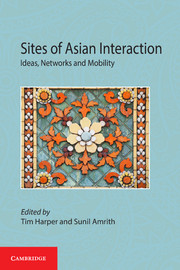Book contents
- Frontmatter
- Contents
- List of figures
- Preface
- Introduction
- 1 Singapore, 1915, and the Birth of the Asian Underground
- 2 Living in the Material World: Cosmopolitanism and Trade in Early Twentieth Century Ladakh
- 3 Nation, Race, and Language: Discussing Transnational Identities in Colonial Singapore, circa 1930
- 4 Intimate Interactions: Eurasian Family Histories in Colonial Penang
- 5 Citing as a Site: Translation and Circulation in Muslim South and Southeast Asia
- 6 Popular Sites of Prayer, Transoceanic Migration, and Cultural Diversity: Exploring the significance of keramat in Southeast Asia
- 7 Connecting People: A Central Asian Sufi network in turn-of-the-century Istanbul
- 8 ‘Enough of the Great Napoleons!’ Raja Mahendra Pratap's Pan-Asian Projects (1929–1939)
- 9 Chinatowns and Borderlands: Inter-Asian Encounters in the Diaspora
- 10 Creating Spaces for Asian Interaction through the Anti-Globalisation Campaigns in the Region
- Contributors
- Index
Introduction
Published online by Cambridge University Press: 05 July 2014
- Frontmatter
- Contents
- List of figures
- Preface
- Introduction
- 1 Singapore, 1915, and the Birth of the Asian Underground
- 2 Living in the Material World: Cosmopolitanism and Trade in Early Twentieth Century Ladakh
- 3 Nation, Race, and Language: Discussing Transnational Identities in Colonial Singapore, circa 1930
- 4 Intimate Interactions: Eurasian Family Histories in Colonial Penang
- 5 Citing as a Site: Translation and Circulation in Muslim South and Southeast Asia
- 6 Popular Sites of Prayer, Transoceanic Migration, and Cultural Diversity: Exploring the significance of keramat in Southeast Asia
- 7 Connecting People: A Central Asian Sufi network in turn-of-the-century Istanbul
- 8 ‘Enough of the Great Napoleons!’ Raja Mahendra Pratap's Pan-Asian Projects (1929–1939)
- 9 Chinatowns and Borderlands: Inter-Asian Encounters in the Diaspora
- 10 Creating Spaces for Asian Interaction through the Anti-Globalisation Campaigns in the Region
- Contributors
- Index
Summary
Recent work in history, anthropology, and related disciplines has opened up new ways of thinking about inter-Asian connections. The contributors to this book aim to ground these themes in a concerted focus on particular spaces or sites. We suggest that sites can, in themselves, be constitutive of particular modes of Asian interactions. Much recent literature on Asian transnationalism has focused on Asian elites and on textual modes of interaction, notably focusing on the writings of pre-eminent Asian intellectuals and literary figures. In thinking about spaces of interaction, we aim to broaden the focus of discussion to include non-elite Asians and their interactions with each other. By focusing on spaces—real and virtual—these articles begin to conceive new ways of capturing changing geographical imaginations and the fluidity of borders and boundaries across Asia.
Border towns; university dormitories; madrasas; places of transit; refugee camps; places of work, from rubber plantations to oil fields; the meetings of Asian non-governmental and activist organisations; the sites of major inter-Asian conferences of statesmen, which sometimes assume symbolic significance; virtual sites of Asian interaction, found in the hyperlinked websites of Asian insurgent groups—these are among the sites we hope that the articles here, and the theoretical perspectives they provide, might open up for discussion and further research. Taken together, these articles might be seen as a contribution to the study of what Engseng Ho has called ‘local cosmopolitanism’, and also to its limitations and tensions.
- Type
- Chapter
- Information
- Sites of Asian InteractionIdeas, Networks and Mobility, pp. 1 - 9Publisher: Cambridge University PressPrint publication year: 2014

